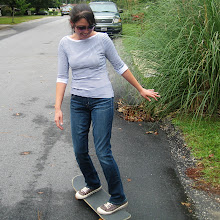I'd love to hear how you all work with these types of threads!!
This week's SBQ was suggested by Ish and is:
Which project (finished or in progress) are you most proud of? Explain why.I don't know that any one jumps out at me. But, I guess I would say I'm pretty proud of my very first piece, as simple (and probably poorly done) as it is. My husband was away in training for 5 months and my son had just been born. I was all by myself and looking for a new hobby, and wanted to make something for my son. I stumbled across some cross stitching chart books at the craft store and combined a few different charts to make this one. So, I guess I'm proud that I found and taught myself something that I've grown to really love. :)


4 comments:
What Erica Michaels said about her piece Winter (meant to be stitched in variegated threads) was to work the stitches in a circle in the motif so the motif wouldn't come out so stripy. When I did the reindeer in Winter in Designers' Dream, I didn't realize that the wool was variegated, therefore there are some unwanted stripes. But only towards the bottom and not enough that most people will notice.
When I was working on the ocean in Pineapple Fish, I was confetti stitching all over the place so avoid stripes and clumps. The sky is also variegated thread, but since skies can be more "clumpy" I simply change directions after each piece of thread so that the clumps are more random.
I am going to start a small alphabet sampler with some Weeks Dye Works variegated thread. I will probably just let the colors fall where they may except when I get to the lighthouse. I will either stitch that with a DMC solid or be VERY careful where I place the thread varieties.
Jennifer, I use overdyed threads exactly as you described.
The trick to getting the colours to match when ending a thread is...
Remember which end of the length you cut off that you pulled the thread from thread that end where you pulled it from into the eye of te needle. When you start the next, new thread pull the strands from the other end and put those ends through the eye of the needles. Where you finished and where you start should match fairly closely.
Another trick I got from Jeannette Douglas is when you're working with an overdyed thread and there's a little part of it you don't like... say there's a bit of brown and you don't want it... cut it out! Why stitch with a bit you don't like???
Going side to side is not the only option you could go vertically or horizontally... it depends on the effect you desire.
Oh yeah one stitch at a time is the only way to go.
I do the same as Dani, alternating which end of the floss I start with. Stitching with two strands that mean when you finish the six cut strands you ending stitch should match up to the tail end of the floss.
I don't think one at a time stitching is the final rule. One at a time gives you moderate changes in colour, while stitching bottoms first then going back and doing tops gives you a gentler colour change within the row, but bigger colour differences between rows. In this project I used DMC variegated for the hair and skirt. The hair was stitched bottom first, then top. The skirt was stitched one at a time. It just depends on what effect you're going for. :)
I think your first piece is adorable, and congrats on not only doing it as a first piece but by being brave enough to combine a couple of different patterns.
As to using varigated threads, I change how I use them depending on the effect I want. If I want very subtle shading, I stitch as I regularly do, going across the row and then coming back. If I want a more striking change I complete each stitch as I go. If I want to avoid the impression of lines due to color changing I'll kind of skip around a bit as I place each individual stitch.
Sue
Post a Comment